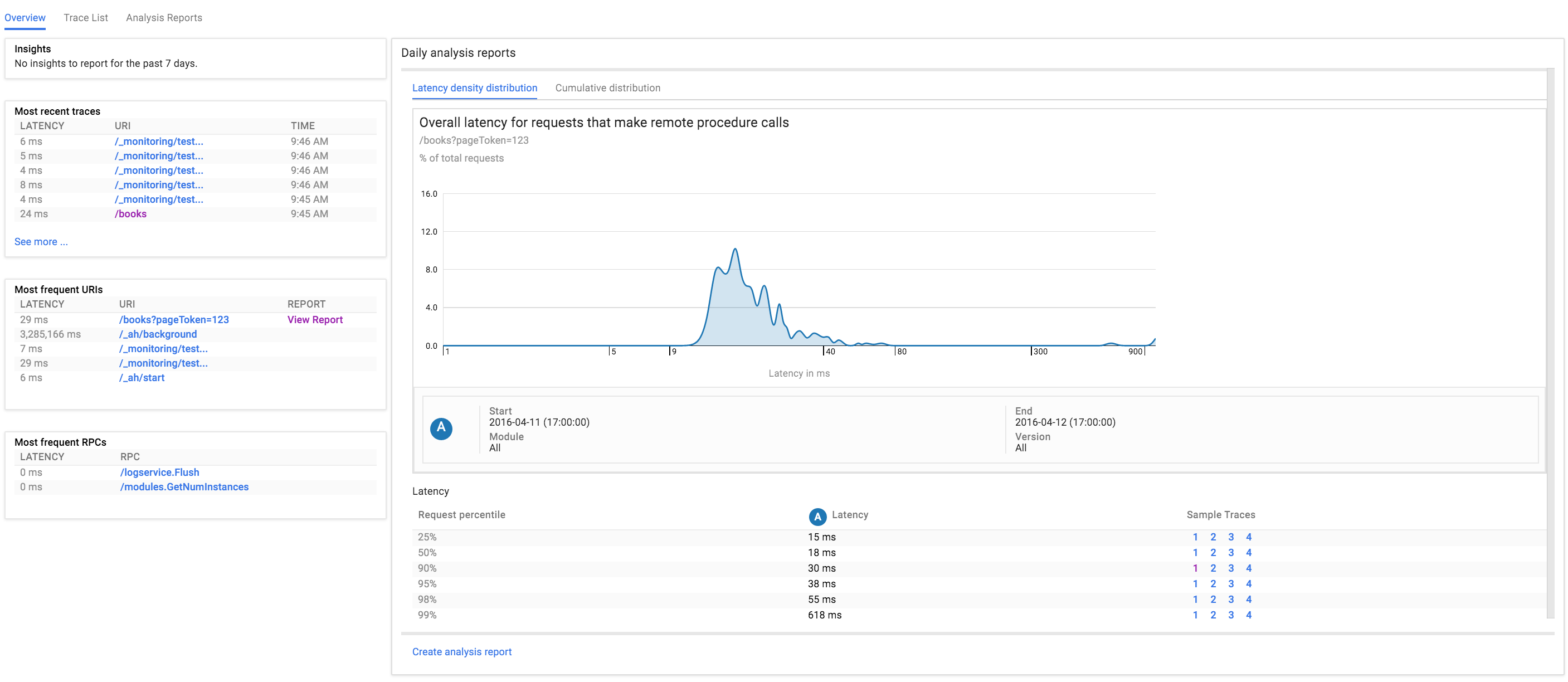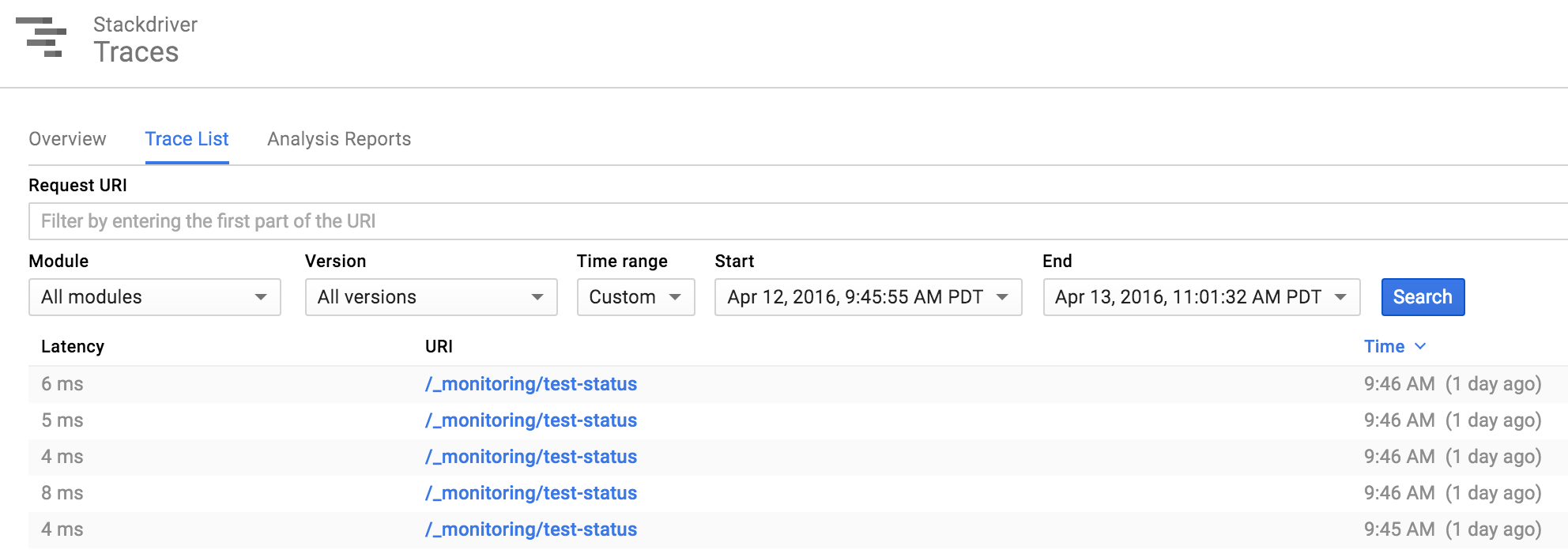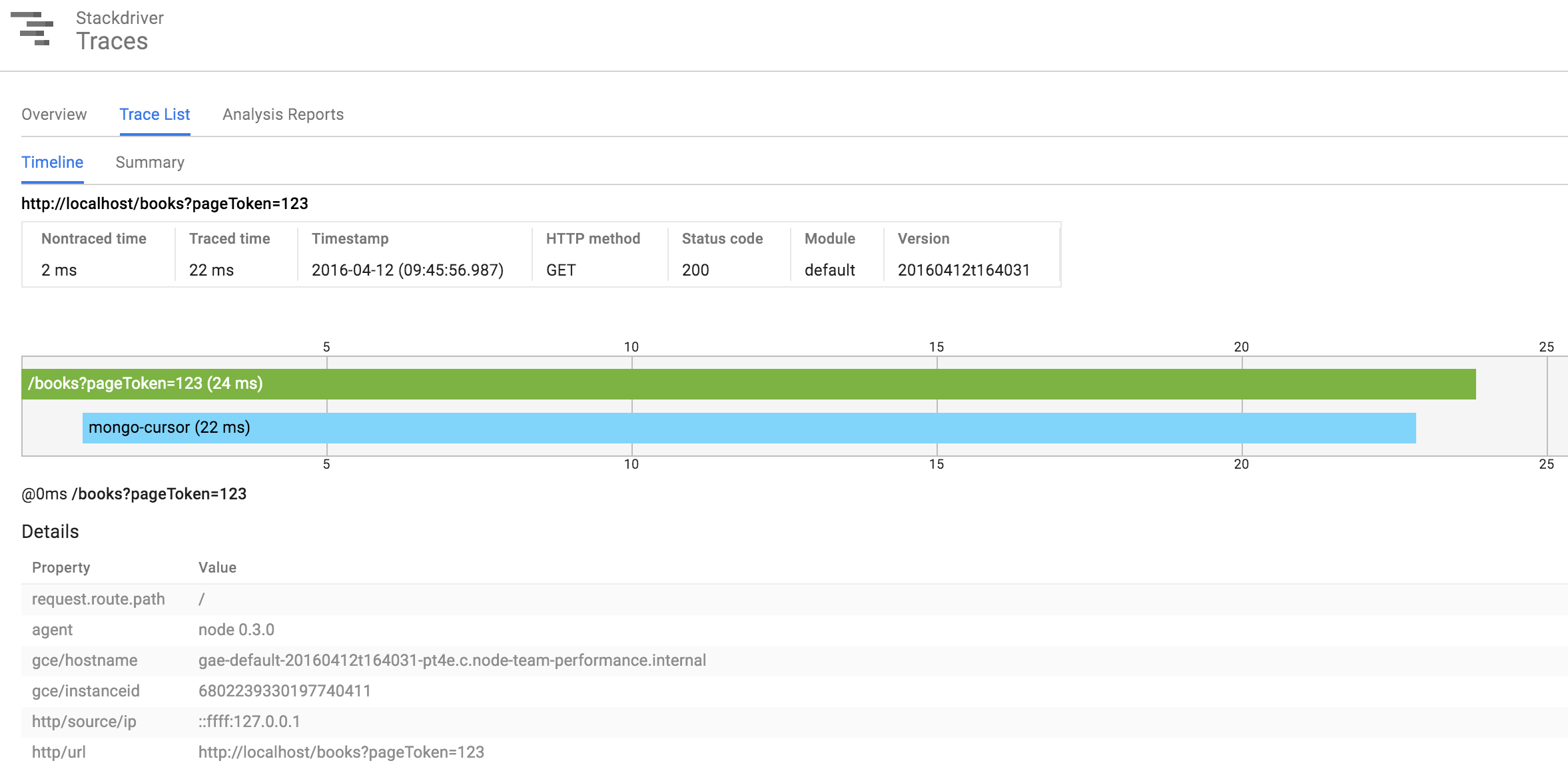Stackdriver Trace for Node.js
Beta. This is a Beta release of the Stackdriver Trace agent for Node.js. These libraries might be changed in backward-incompatible ways and are not subject to any SLA or deprecation policy.
This module provides Stackdriver Trace support for Node.js applications. Stackdriver Trace is a feature of Google Cloud Platform that collects latency data (traces) from your applications and displays it in near real-time in the Google Cloud Console.
Prerequisites
- Your application will need to be using Node.js version 4.0 or greater.
- You will need a project in the Google Developers Console. Your application can run anywhere, but the trace data is associated with a particular project.
- Enable the Trace API for your project.
Tracing with async/await
Using the trace agent to trace applications using untranspiled async/await is not currently supported by default.
Versions 2.2+ ship with an experimental implementation (using the Node 8 async_hooks API) that supports async/await. To enable this implementation, run your application in an environment where the environmental variable GCLOUD_TRACE_NEW_CONTEXT is set:
# Requires Node 8+
$ GCLOUD_TRACE_NEW_CONTEXT=1 npm startWe are actively looking for feedback on this new implementation. Please file an issue if you encounter unexpected or unwanted behavior.
See this section for more information.
Installation
-
Install with
npmor add to yourpackage.json.# Install through npm while saving to the local 'package.json' npm install --save @google-cloud/trace-agent -
Set the GCLOUD_PROJECT environment variable. You can find your Project ID in the Google Cloud Developers Console, or by running the command
gcloud projects list. You can ensure this environment variable is set at startup time by placing it in your startup script inpackage.json:"scripts": { "start": "GCLOUD_PROJECT=<YOUR_PROJECT_ID> node server.js", },
-
Include and start the library as the very first action in your application:
var agent = require('@google-cloud/trace-agent').start();
If you use --require in your start up command, make sure that the trace agent is --required first.
- If you are running your application locally, or on a machine where you are using the Google Cloud SDK, make sure to log in with the application default credentials:
gcloud beta auth application-default login
If you are running somewhere other than the Google Cloud Platform, see running elsewhere.
Configuration
See the default configuration for a list of possible configuration options. These options can be passed to the agent through the object argument to the start command shown above:
require('@google-cloud/trace-agent').start({samplingRate: 500});Alternatively, you can provide configuration through a config file. This can be useful if you want to load our module using --require on the command line instead of editing your main script. You can start by copying the default config file and modifying it to suit your needs. The GCLOUD_TRACE_CONFIG environment variable should point to your configuration file.
export GCLOUD_TRACE_CONFIG=./path/to/your/trace/configuration.jsRunning on Google Cloud Platform
There are three different services that can host Node.js applications within Google Cloud Platform.
Google App Engine flexible environment
If you are using Google App Engine flexible environment, you do not have to do any additional configuration.
Google Compute Engine
For Google Compute Engine instances, you need to explicitly enable the https://www.googleapis.com/auth/trace.append access scope for each instance. When creating a new instance through the Google Cloud Platform Console, you can do this under Identity and API access: Use the Compute Engine default service account, select the Set access for each API access scopes option, and ensure that the Stackdriver Trace access is set to Write Only.
To enable to scope on existing GCE instances, you can follow the instructions for using a service account under running elsewhere.
Google Container Engine
As with Compute Engine, Container Engine nodes need to be created with the https://www.googleapis.com/auth/trace.append scope, which is configurable during cluster creation:
-
If the cluster is being created with the
gcloudCLI, pass the scope to the command with the--scopescommand (multiple scopes can be delimited with a comma):gcloud container clusters create example-cluster-name --scopes https://www.googleapis.com/auth/trace.append
-
If the cluster is being created through the Cloud Console UI, ensure that the "Stackdriver Trace" project access is set to "Write Only" (this is the default).
Alternatively, you can also follow the instructions for using a service account under running elsewhere. It's recommended that you store the service account credentials as Kubernetes Secret.
Running elsewhere
If your application is running outside of Google Cloud Platform, such as locally, on-premise, or on another cloud provider, you can still use Stackdriver Trace.
-
You will need to specify your project ID when starting the trace agent.
GCLOUD_PROJECT=particular-future-12345 node myapp.js
-
You need to provide service account credentials to your application. The recommended way is via Application Default Credentials.
-
Copy the key somewhere your application can access it. Be sure not to expose the key publicly.
-
Set the environment variable
GOOGLE_APPLICATION_CREDENTIALSto the full path to the key. The trace agent will automatically look for this environment variable.
If you are running your application on a development machine or test environment where you are using the gcloud command line tools, and are logged using gcloud beta auth application-default login, you already have sufficient credentials, and a service account key is not required.
Alternatively, you may set the keyFilename or credentials configuration field to the full path or contents to the key file, respectively. Setting either of these fields will override either setting GOOGLE_APPLICATION_CREDENTIALS or logging in using gcloud. (See the default configuration for more details.)
Viewing your traces
Run your application and start sending some requests towards your application. In about 30 seconds or so, you should see trace data gathered in the STACKDRIVER -> Traces -> Trace List in the console:
This is the trace list that shows a sampling of the incoming requests your application is receiving. You can click on a URI to drill down into the details. This will show you the RPCs made by your application and their associated latency:
What gets traced
The trace agent can do automatic tracing of the following web frameworks:
- express (version 4)
- gRPC* server (version 1)
- hapi (versions 8 - 16)
- koa (version 1)
- restify (versions 3 - 6)
The agent will also automatic trace of the following kinds of RPCs:
- Outbound HTTP requests through the
httpandhttpscore modules - gRPC* client (version 1)
- MongoDB-core (version 1)
- Mongoose (version 4)
- Redis (versions 0.12 - 2)
- MySQL (version ^2.9)
*Note: The latest versions of gRPC (versions 1.1 and up) have dropped support for Node.js <4.0. We do not support tracing gRPC on unsupported versions of Node.js.
You can use the Custom Tracing API to trace other processes in your application.
We are working on expanding the types of frameworks and services we can do automatic tracing for. We are also interested in hearing your feedback on what other frameworks, or versions, you would like to see supported. This would help us prioritize support going forward. If you want support for a particular framework or RPC, please file a bug or +1 an existing bug.
Advanced trace configuration
The trace agent can be configured by passing a configurations object to the agent start method. This configuration option accepts all values in the default configuration.
One configuration option of note is enhancedDatabaseReporting. Setting this option to true will cause database operations for redis and MongoDB to record query summaries and results as labels on reported trace spans.
Trace batching and sampling
The aggregation of trace spans before publishing can be configured using the flushDelaySeconds and bufferSize options. The spans recorded for each incoming requests are placed in a buffer after the request has completed. Spans will be published to the UI in batch when the spans from bufferSize requests have been queued in the buffer or after flushDelaySeconds have passed since the last publish, whichever comes first.
The trace configuration additionally exposes the samplingRate option which sets an upper bound on the number of traced requests captured per second. Some Google Cloud environments may override this sampling policy.
Tracing Additional Modules
In addition to the modules listed above, the trace agent can be configured to trace additional modules through the use of plugins. To load an additional plugin, specify it in the agent's configuration:
require('@google-cloud/trace-agent').start({
plugins: {
// You may use a package name or absolute path to the file.
'my-module': '@google-cloud/trace-agent-plugin-my-module',
'another-module': path.join(__dirname, 'path/to/my-custom-plugins/plugin-another-module.js')
}
});This list of plugins will be merged with the list of built-in plugins, which will be loaded by the plugin loader. Each plugin is only loaded when the module that it patches is loaded; in other words, there is no computational overhead for listing plugins for unused modules.
To create a plugin for a module, please see the Plugin Developer Guide.
Custom Tracing API
The custom tracing API can be used to add custom spans to trace. A span is a particular unit of work within a trace, such as an RPC request. Spans may be nested; the outermost span is called a root span, even if there are no nested child spans. Root spans typically correspond to incoming requests, while child spans typically correspond to outgoing requests, or other work that is triggered in response to incoming requests.
For any of the web frameworks for which we provide built-in plugins, a root span is automatically started whenever an incoming request is received (in other words, all middleware already runs within a root span). If you wish to record a span outside of any of these frameworks, any traced code must run within a root span that you create yourself.
Accessing the API
Calling the start function returns an instance of TraceApi, which provides an interface for tracing:
var traceApi = require('@google-cloud/trace-agent').start();It can also be retrieved by subsequent calls to get elsewhere:
// after start() is called
var traceApi = require('@google-cloud/trace-agent').get();A TraceApi object is guaranteed to be returned by both of these calls, even if the agent is disabled.
A fully detailed overview of the TraceApi object is available here.
How does automatic tracing work?
The Trace Agent automatically patches well-known modules to insert calls to functions that start, label, and end spans to measure latency of RPCs (such as mysql, redis, etc.) and incoming requests (such as express, hapi, etc.). As each RPC is typically performed on behalf of an incoming request, we must make sure that this association is accurately reflected in span data. To provide a uniform, generalized way of keeping track of which RPC belongs to which incoming request, we rely on the continuation-local-storage module to keep track of the "trace context" across asynchronous boundaries.
This method, which relies on async-listener to preserve continuations over asynchronous boundaries, works great in most cases. However, it does have some limitations that can prevent us from being able to properly propagate trace context:
- It is possible to use JavaScript code that does its own queuing of callback functions – effectively merging asynchronous execution contexts. For example, one may write a http request buffering library that queues requests and then performs them in a batch in one shot. In such a case, when all the callbacks fire, they will execute in the context which flushed the queue instead of the context which added the callbacks to the queue. This problem is called the pooling problem or the user-space queuing problem, and is a fundamental limitation of JavaScript. If your application uses such code, you will notice that RPCs from many requests are showing up under a single trace, or that certain portions of your outbound RPCs do not get traced. In such cases we try to work around the problem through monkey patching, or by working with the library authors to fix the code to properly propagate context. However, finding problematic code is not always trivial.
- Presently, it is not possible for async-listener to keep track of async transitions in ES7 async/await functions that are available with Node 7.6+. If your application uses untranspiled async functions, we will not be properly track RPCs. We do expect to be able to track native async/await functions in the once async-listener has support for the new async-hooks API.
Contributing changes
- See CONTRIBUTING.md
Licensing
- See LICENSE


